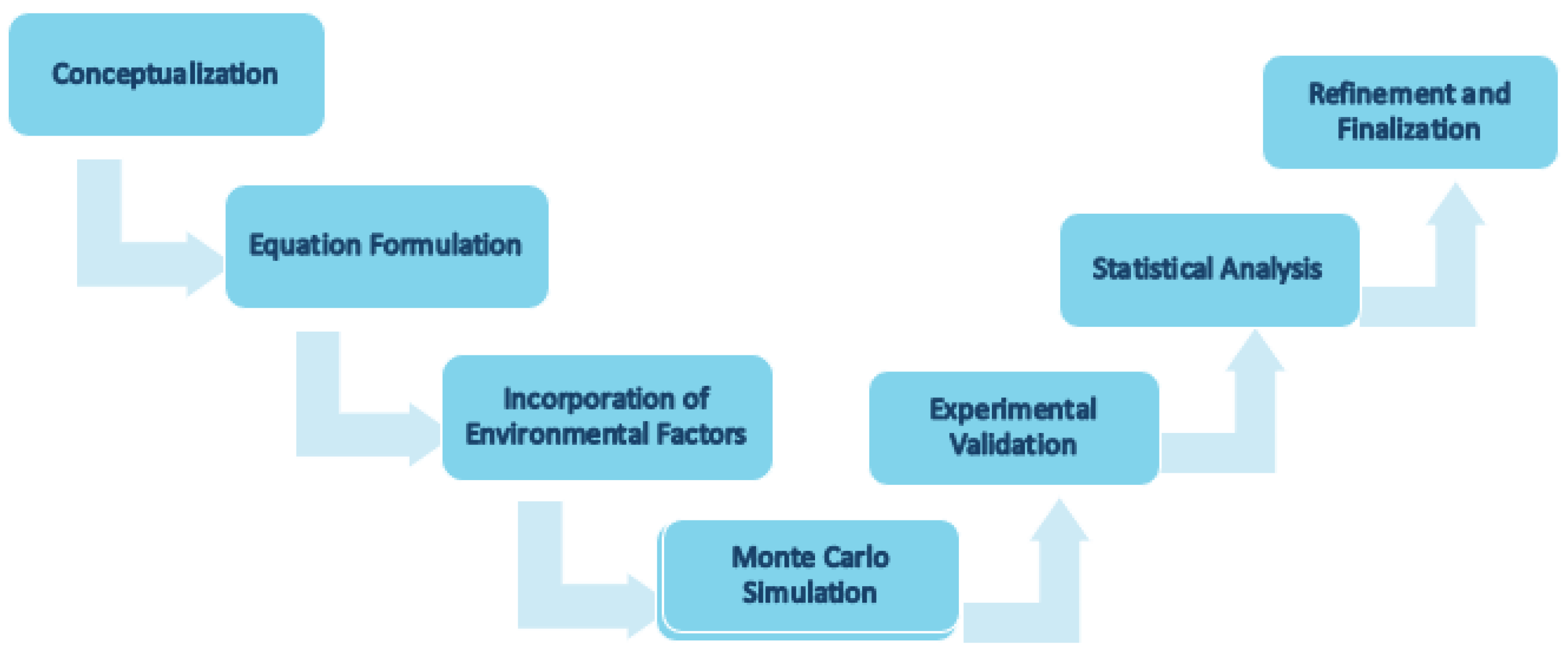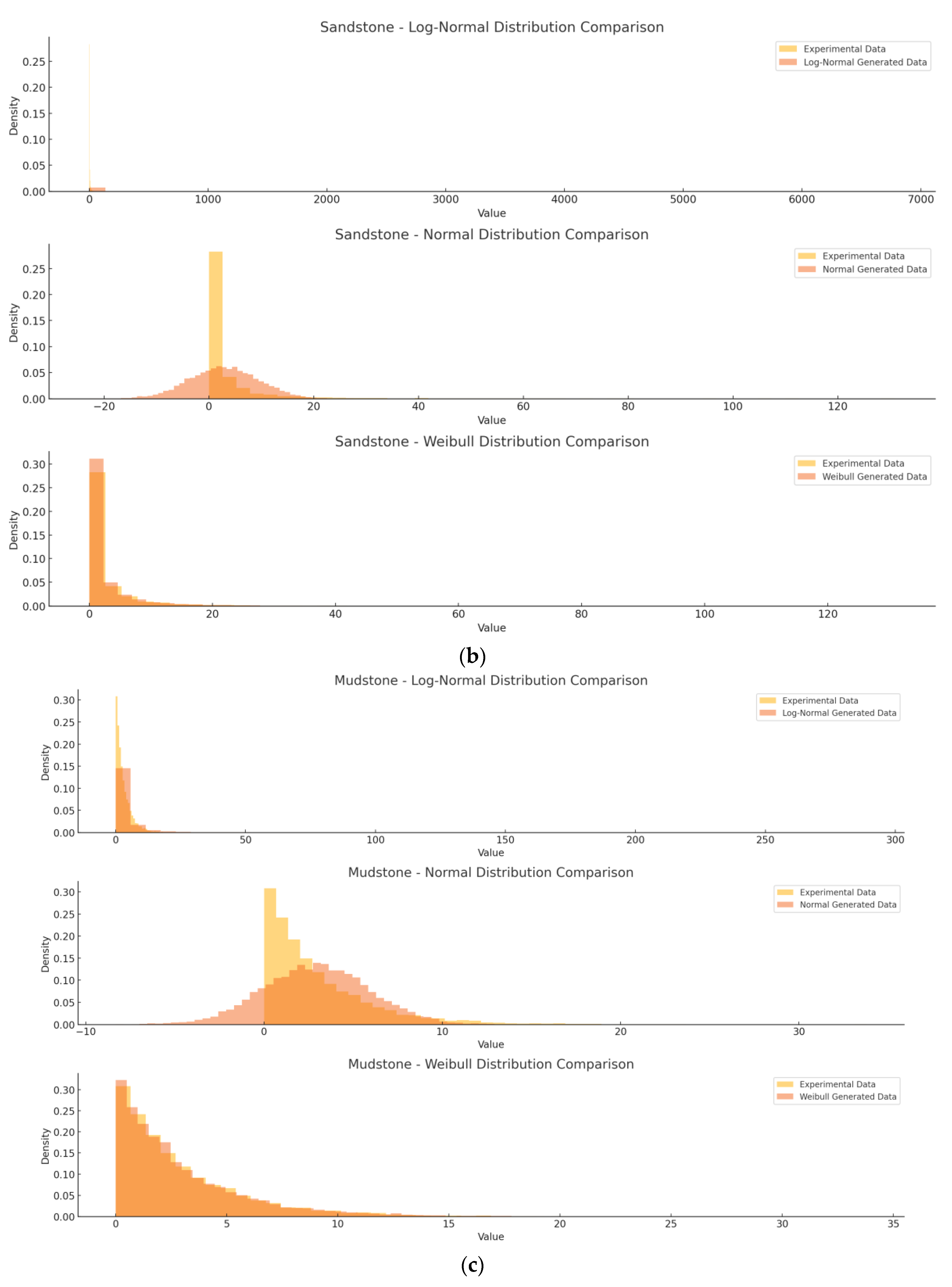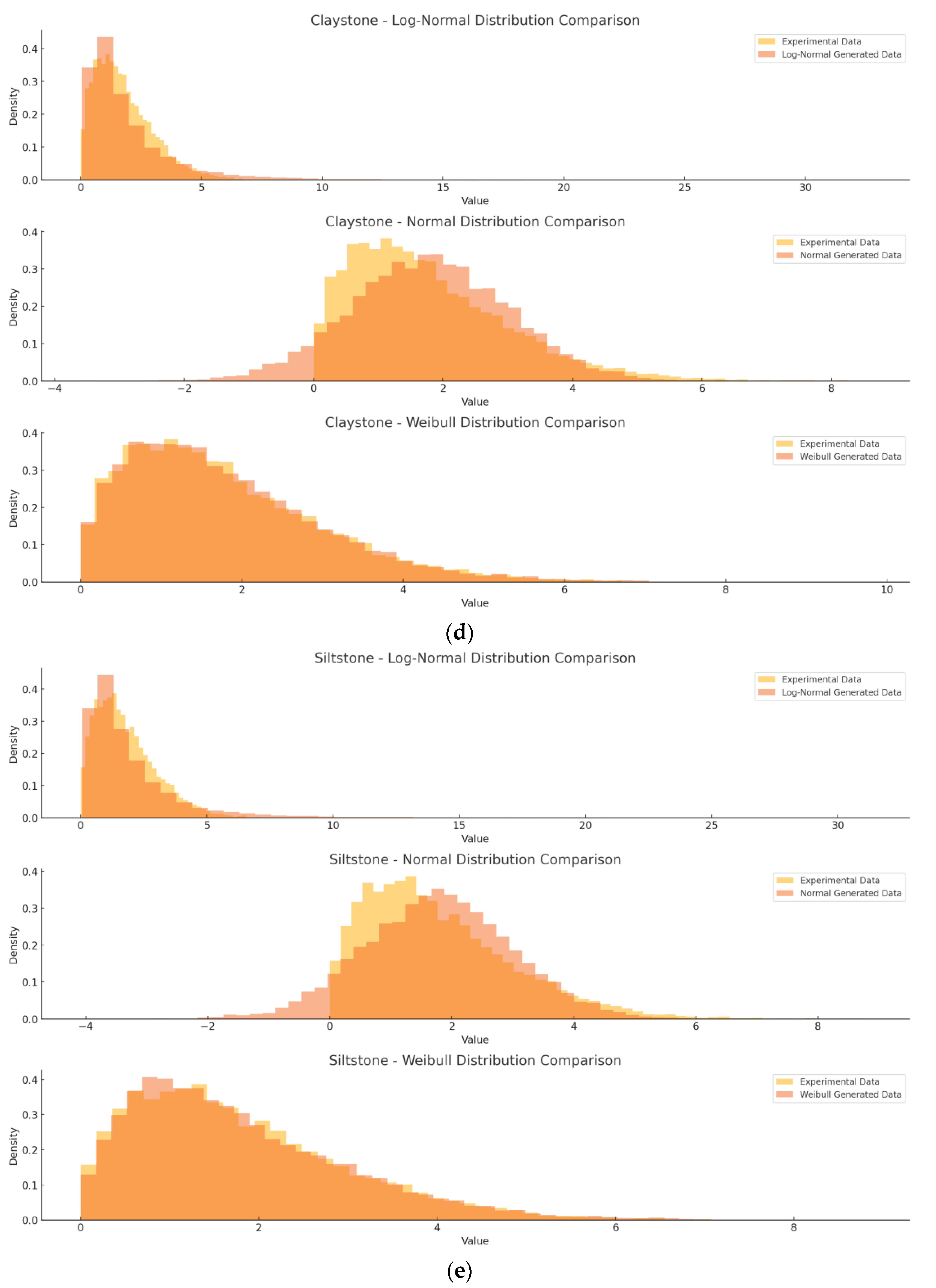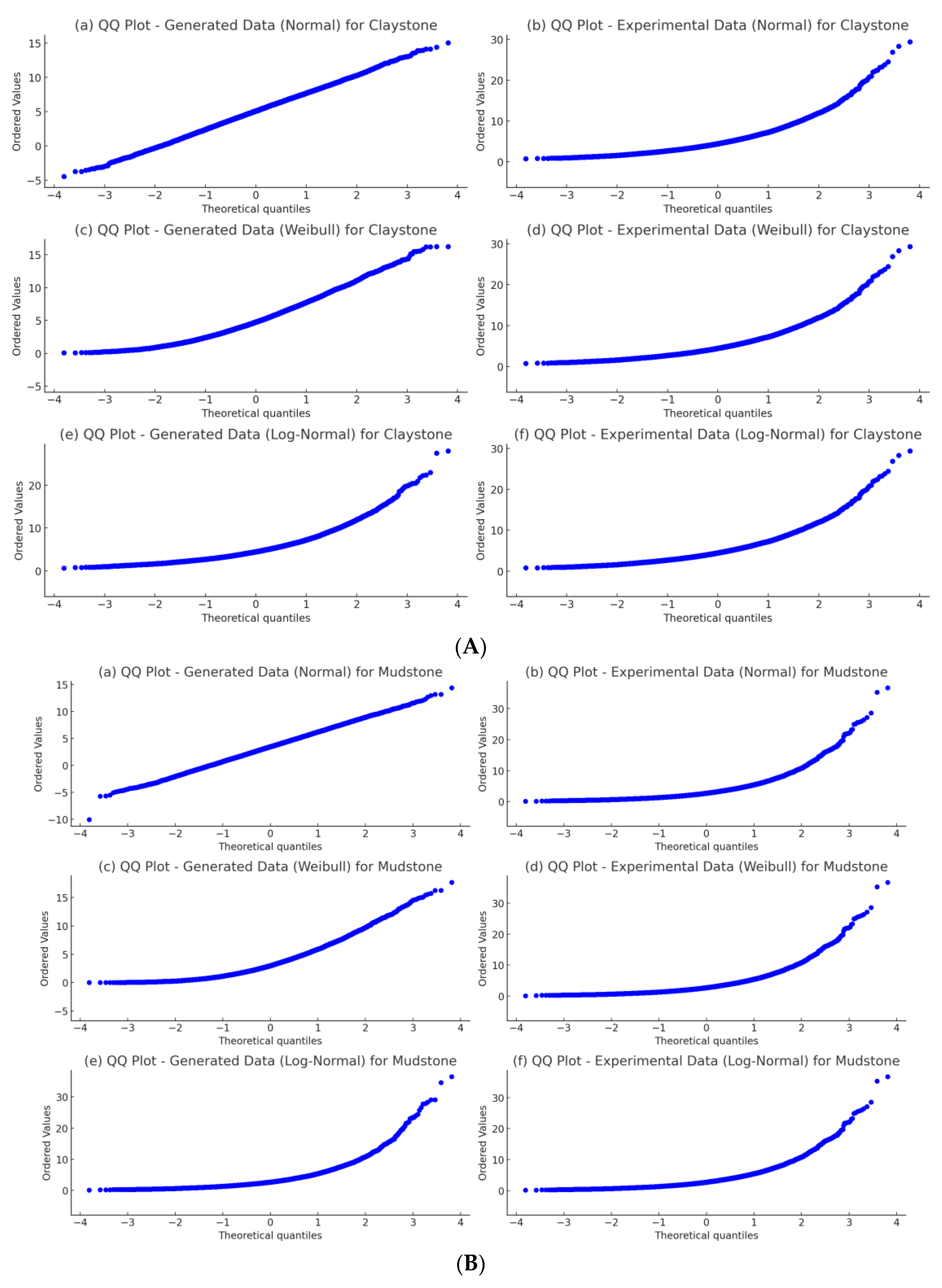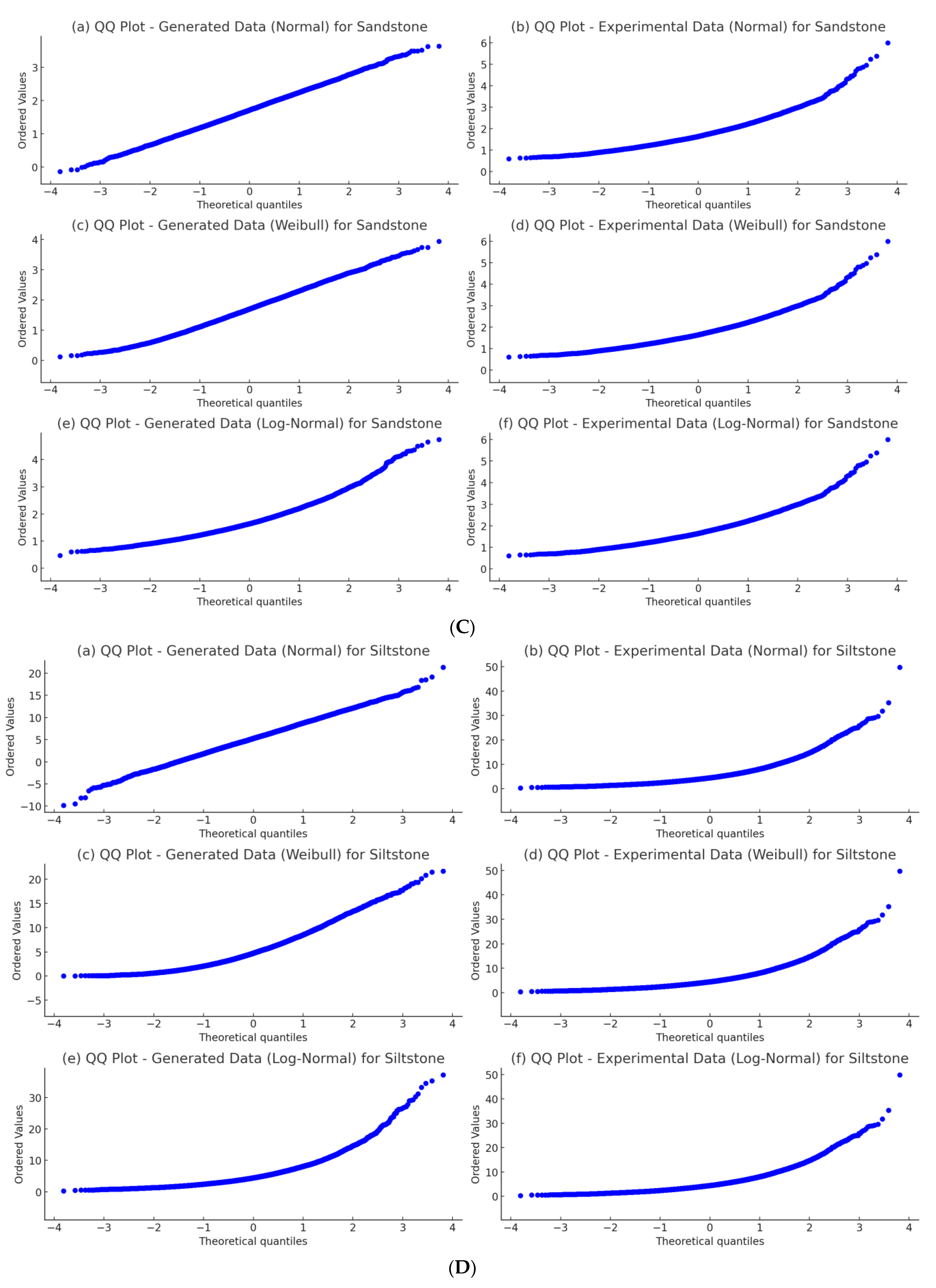1. Introduction
The stability and mechanical behavior of weak rock masses are pivotal to numerous engineering applications, particularly in a field such as mining engineering. These formations are often characterized by low strength and high deformability, posing significant challenges due to their complex response to environmental and operational stresses. Weak rock masses commonly exhibit anisotropic behavior, where mechanical properties vary with directional dependencies linked to geological features like foliation, bedding planes, and joints. Consequently, simulating these formations accurately requires advanced constitutive models that capture the interplay of stress anisotropy, pore pressure, deviatoric stress, and temperature fluctuations. Previous research has established models primarily for stronger rock formations; however, such models often lack the adaptability to replicate the nonlinear and probabilistic responses of weak rock masses under field conditions. For instance, ref. [
1] emphasized the importance of incorporating deviatoric stress to predict deformation in weak formations accurately, while Ref. [
2] demonstrated the significance of stress anisotropy on weak rock mass behavior. Similarly, ref. [
3] introduced mechanisms to account for pore pressure effects in fluid-saturated environments which critical for formations like aquifers and geothermal fields, where pore pressure significantly influences deformation and failure [
4].
This study addresses these limitations by presenting a comprehensive constitutive model for weak rock mass behavior, incorporating anisotropic stress components, pore pressure effects, and environmental factors like temperature changes. To validate this model, a Monte Carlo simulation approach was employed, allowing for an in-depth probabilistic analysis that reflects the inherent variability in geological properties through Weibull distributions. This approach aligns with recent methodologies that aim to bridge the gap between experimental and synthetic data by enhancing model sensitivity and specificity to weak rock mass conditions.
Through this research, we aim to advance predictive capabilities in geomechanical modeling, facilitating safer and more efficient designs in projects involving weak rock formations. The findings provide a practical tool for applications in mining, geothermal energy, oil reservoirs, and aquifer management, aligning with the growing need for models that can accurately simulate weak rock mass responses under diverse environmental and operational conditions.
3. Results and Discussion
The constitutive model developed in this study was applied to different rock masses including siltstone, claystone, mudstone, sandstone, and shale. The simulations were conducted using Monte Carlo methods, incorporating Weibull, log-normal, and normal distributions to account for variability in material properties. To ensure the reliability of the proposed model, a thorough comparison between the generated data from simulations and experimental data was performed. The primary goal of this validation process is to assess whether the simulated data, which are derived from three different distributions, accurately represent the experimental outcomes for each rock type. In this regard, both statistical and visual analyses were performed to evaluate the congruence between the two datasets.
3.1. Validation Methodology
The validation was conducted using both statistical and visual methods. First, the Weibull distribution was fitted to the experimental data to estimate its shape and scale parameters. The synthesized data were then generated for each rock type. Furthermore, to statistically assess the similarity between generated and experimental data, we employed the Kolmogorov–Smirnov test, a non-parametric statistical test used to determine whether two datasets differ significantly. In this test, a high p-value (higher than 0.05) was considered to indicate no significant difference between the two distributions.
Additionally, we employed histograms and quantile–quantile (Q–Q) plots to visually compare the distributions of the experimental and generated data.
3.2. Statistical Validation and Distribution Analysis
The comparison between generated and experimental data using different statistical distributions has provided new insights into the behavior of rock masses. By using the Kolmogorov–Smirnov test and analyzing quantile–quantile (Q–Q) plots and histograms, we can obtain a more refined evaluation of the model’s performance for each rock type.
The Kolmogorov–Smirnov test revealed no statistically significant difference between the empirical and simulated deformation distributions for all rock types. The high
p-values obtained from the test indicate a failure to reject the null hypothesis (
Table 1). This implies that the observed differences between the experimental and simulated data could have arisen by chance alone. Therefore, the statistical analysis supports the conclusion that the model accurately represents the deformation behavior of the tested rock types. While the Kolmogorov–Smirnov (KS) test is a useful non-parametric method for comparing distributions, its sensitivity can be limited when applied to large datasets (n > 5000) or distributions with heavy tails. In such cases, the KS test may fail to detect subtle yet important differences. Therefore, for a more robust assessment, particularly when dealing with large sample sizes or heavy-tailed distributions, the Anderson–Darling test is recommended. This test offers increased sensitivity to discrepancies in the tails of the distributions, providing a more comprehensive evaluation of the goodness of fit.
Table 2,
Table 3 and
Table 4 show the mean and standard deviation of the simulated data were also closely aligned with those of the experimental data, further supporting the robustness of the model [
20].
The statistical analysis showed that the Weibull distribution generated the most reliable results. The Kolmogorov–Smirnov (KS) test demonstrated consistently high p-values across all rock types (e.g., claystone: 0.60, shale: 0.91), indicating that the Weibull distribution effectively captures the variability and heterogeneity inherent in weak rock masses.
In comparison, the log-normal distribution exhibited intermediate performance. It produced reasonably high p-values for some rock types, such as claystone (0.81), but demonstrated poorer alignment for others, like siltstone, where the p-value decreased to 0.12. This suggests that while the log-normal distribution is adequate for certain cases, it is less universally applicable than the Weibull distribution.
On the other hand, the normal distribution showed the least consistent performance, with lower p-values for several rock types (e.g., claystone: 0.019), indicating a poor fit in many scenarios. This highlights the limitations of using the normal distribution for modeling the complex behavior of weak, heterogeneous rock masses.
The observed high standard deviations in the deformation measurements could be attributed to several factors inherent to both the experimental methodology and the intrinsic properties of the rock samples:
3.3. Material Heterogeneity
Rock types such as sandstone and mudstone exhibit significant heterogeneity in their physical and mechanical properties, including porosity, grain size, and mineral composition. This inherent variability, even within the same lithological classification, leads to a wide range of deformation behaviors under stress, contributing to the observed high standard deviations.
3.4. Variable Uniaxial Compressive Strength (UCS)
The wide range of UCS values for each rock type (e.g., 20–100 MPa for sandstone) further contributes to the variability in deformation response. The inherent strength variability within each rock type influences how individual samples deform under load, resulting in a broader distribution of measured deformation values [
19].
3.5. Experimental Uncertainties
Experimental measurements on natural materials like rocks are inherently subject to variability. Factors such as sample preparation techniques, testing conditions, and measurement errors can all contribute to the observed standard deviations. For instance, the high standard deviation (7.65) in the experimental deformation values for sandstone likely reflects the unpredictable behavior of real rock samples under stress.
3.6. Simulation-Induced Variability
In the synthetic data generated by Monte Carlo simulation using the Weibull distribution, the variability in input parameters, such as UCS and other rock properties, propagates through the simulation, leading to variability in the output deformation values. This effect is amplified when input parameters have wide distributions or significant uncertainty. For example, the high standard deviation in the simulated deformation of sandstone can be attributed to the wide range of UCS values and the inherent variability of this rock type.
Sandstone: Exhibits the highest standard deviation due to a combination of factors, including a wide range of porosities, grain structures, and UCS values. These factors contribute to different deformation behaviors in different sandstone samples.
Mudstone: While exhibiting lower variability compared to sandstone, mudstone still shows a relatively high standard deviation, likely due to its fine-grained structure and variations in clay content.
Siltstone and Shale: These rock types have lower standard deviations compared to sandstone. However, variability in their structure and mineral content remains notable, contributing to the observed spread in deformation measurements.
In summary, the high standard deviations, particularly in the experimental data collected from the literature, are a consequence of the natural heterogeneity of the rock types (including the effect of microfractures, grain boundaries, and pore spaces), the wide range of UCS values, potential experimental uncertainties. The synthetic data, while exhibiting lower standard deviations due to controlled simulation environments, still reflect the inherent variability in rock properties and their influence on deformation behavior.
3.7. Visual Analysis
The histograms in
Figure 1 provide a visual comparison of the density distributions for the simulated and experimental data for different rock masses using three different distributions. As observed, the histograms for both datasets generated by Weibull distribution overlap significantly, indicating that the generated data mirror the experimental results for each rock type, whereas normal and log normal distributed data often showed discrepancies. The y-axis represents probability density, normalized for comparative analysis. A higher density at a given deformation value (x-axis) indicates that it occurs more frequently in the dataset. The Weibull distribution shows the best fit, as it captures the extreme values and skewed nature of weak rock mass deformation, while the normal distribution fails to represent the asymmetric nature of failure mechanisms.
Furthermore, the Q–Q plots show that the quantiles of the data generated by the Weibull distribution align closely with the quantiles of the experimental data illustrated in
Figure 2. This visual alignment confirms that the simulated data follow the same distribution as the experimental data, further validating the accuracy of the model. However, the normal distribution showed the most divergence, reinforcing the need for alternative distributions when modeling a weak, anisotropic rock.
In
Figure 3, the consistent alignment between the experimental and Weibull distribution-generated data, as indicated by both statistical tests and visual analysis, provides strong evidence for the reliability of the proposed constitutive model. The high
p-value from the Kolmogorov–Smirnov test and the close agreement between the histograms and Q–Q plots suggest that the model accurately replicates the behavior of the experimental data across various rock types. These findings suggest that the model can be reliably used for predicting the strain behavior of rock formations under given conditions.
3.8. Practical Applications and Advantages
The newly developed constitutive model provides a significant advancement over existing approaches. By integrating stress anisotropy, pore pressure, and environmental factors, it offers a more holistic simulation that is crucial for weak rock masses. Previous research has often fallen short of addressing these interactions comprehensively. For instance, Hajiabdolmajid (2020) [
2] and Nguyen (2022) [
5] provided insights into stress anisotropy and pore pressure effects, respectively, but did not integrate these factors with temperature changes and probabilistic variability as comprehensively as our model does.
Our model’s predictive strength is demonstrated through high congruence between simulated and experimental data and supported by statistical validation methods, such as the Mann–Whitney U test. The absence of significant differences between datasets emphasizes the reliability of our approach, making it a valuable tool for engineers who require robust predictions under variable field conditions. Additionally, the model’s capacity to handle high variability, especially for hard rock types with extensive ranges of unconfined compressive strength (UCS), further enhances its utility across a broader spectrum of geological scenarios.
3.9. Enhanced Constitutive Model for Simulating Thermomechanical Behavior of Weak Rock Masses
This constitutive model presents several key advancements over existing approaches for simulating the behavior of weak rock masses:
Incorporation of Thermal Effects: Unlike previous models, such as that proposed by Bruning et al. (2018) [
1], which focused primarily on the influence of deviatoric stress, this model explicitly incorporates thermal strain effects. This enhancement is crucial for accurately representing the thermomechanical behavior of rock masses in geothermal reservoirs and other high-temperature environments. While the model effectively simulates stress anisotropy, pore pressure effects, and temperature-induced deformations in weak rock masses, further refinements are required to enhance its thermal modeling capabilities. The model currently assumes uniform temperature variations, but real-world scenarios involve non-uniform temperature gradients, variations in thermal properties across rock formations, and heat transfer effects. The role of heat conduction localized thermal expansion, and thermo-mechanical interactions will be studied in future research. Incorporating these factors will improve the accuracy of the model in applications such as geothermal energy extraction, deep underground tunneling, and high-temperature rock mechanics.
Probabilistic Framework: Recognizing the inherent heterogeneity and variability in rock mass properties, this model employs a Monte Carlo simulation framework. This approach, absent in previous studies such as those by Zhao et al. (2016) [
8], enables a more realistic and statistically grounded representation of rock mass behavior by capturing the uncertainty associated with material properties and their impact on deformation.
Balance of Complexity and Usability: This model strikes a balance between capturing the complex thermomechanical behavior of weak rock masses and maintaining practicality for engineering applications. While incorporating advanced constitutive relationships and probabilistic methods, the model remains computationally tractable and accessible to practitioners. This balance ensures that the model can be readily employed for reliable predictions of weak rock mass deformation in a variety of engineering scenarios.
Limitations of the Model
Despite its strengths, our model does have limitations. The reliance on Weibull distributions to represent variability may not capture all the nuances of geological heterogeneity, particularly in cases where rock properties exhibit non-Weibull behavior. Additionally, while the model includes anisotropy and temperature effects, it does not yet consider chemical weathering or the long-term aging of rock masses, which could influence mechanical properties over time. Further research is needed to refine these aspects and explore the impact of these additional factors on rock behavior.
It is important to note that while our model excels in simulating weak rock masses, it is not suitable for hard rock scenarios. The underlying assumptions and parameters, optimized for low-strength and high-deformability conditions, may not capture the mechanical behavior of hard rocks with high unconfined compressive strengths. This limitation is intentional, reflecting our model’s purpose of providing the best possible predictive capabilities for weak rock masses. Engineers dealing with hard rock formations should consider alternative models specifically designed for those conditions.
Future Work
Based on the findings of this study, several areas of future research are identified to further enhance the applicability and accuracy of the proposed constitutive model for weak rock masses:
Expand Distributions Tested: Incorporate additional statistical models such as the Gamma and generalized Pareto distributions to better capture the variability in rock properties and improve the accuracy of probabilistic simulations.
Time-Dependent Analysis: Extend the model to include creep behavior and chemical weathering effects, which are critical for long-term deformation predictions in weak rock masses.
Sensitivity Studies: Conduct sensitivity analyses to determine the most influential parameters affecting the mechanical behavior of weak rock formations and refine the model accordingly.
Validation with Diverse Rock Types: Apply the constitutive model to a wider range of weak and strong rock formations to evaluate its robustness across different geological conditions.
Particle Size Effects: Investigate the role of particle size distribution in weak rock mass behavior, particularly in relation to fracture propagation and failure mechanisms.
Applying Finite Element Method (FEM): Implement FEM-based simulations to improve model precision and validate results with numerical approaches commonly used in geotechnical engineering.
Investigate the Effect of Coupled Parameters: Study the interaction between stress anisotropy, pore pressure, temperature effects, and strain localization to develop a more comprehensive model that captures complex geological behaviors.
These future directions will significantly enhance the predictive capability, reliability, and practical implementation of the model in geomechanical applications such as mining, tunneling, and geothermal energy projects.
Improving Thermal Simulation in Weak Rock Masses:
Temperature Gradients: Future research will integrate transient heat conduction models to simulate spatial temperature variations and heat transfer within rock masses.
Variable Thermal Expansion Coefficients: Different rock types exhibit nonlinear changes in thermal expansion coefficients at elevated temperatures. The model will be refined to capture these variations based on experimental data.
Thermo-Mechanical Coupling: Studies will focus on how temperature changes affect stress anisotropy, deformation mechanisms, and failure behavior.
Experimental Validation: Laboratory experiments will be conducted to measure rock deformation under controlled heating and cooling cycles, improving model calibration for geothermal and deep mining applications.
Parameter Sensitivity Analysis for Model Optimization:
Global Sensitivity Analysis: Future studies will employ variance-based methods such as Sobol’ indices and Morris screening to quantify parameter influence on model outputs.
Local Sensitivity Analysis: Small perturbations will be applied to stress anisotropy, pore pressure, and material variability parameters to assess their impact on deformation behavior.
Machine Learning-Based Sensitivity Assessment: SHAP values and feature importance analysis from random forest models will be explored to understand nonlinear parameter interactions.
Experimental Validation: Sensitivity rankings will be compared with laboratory and field data to ensure that the most critical parameters are correctly weighted in model calibration.
